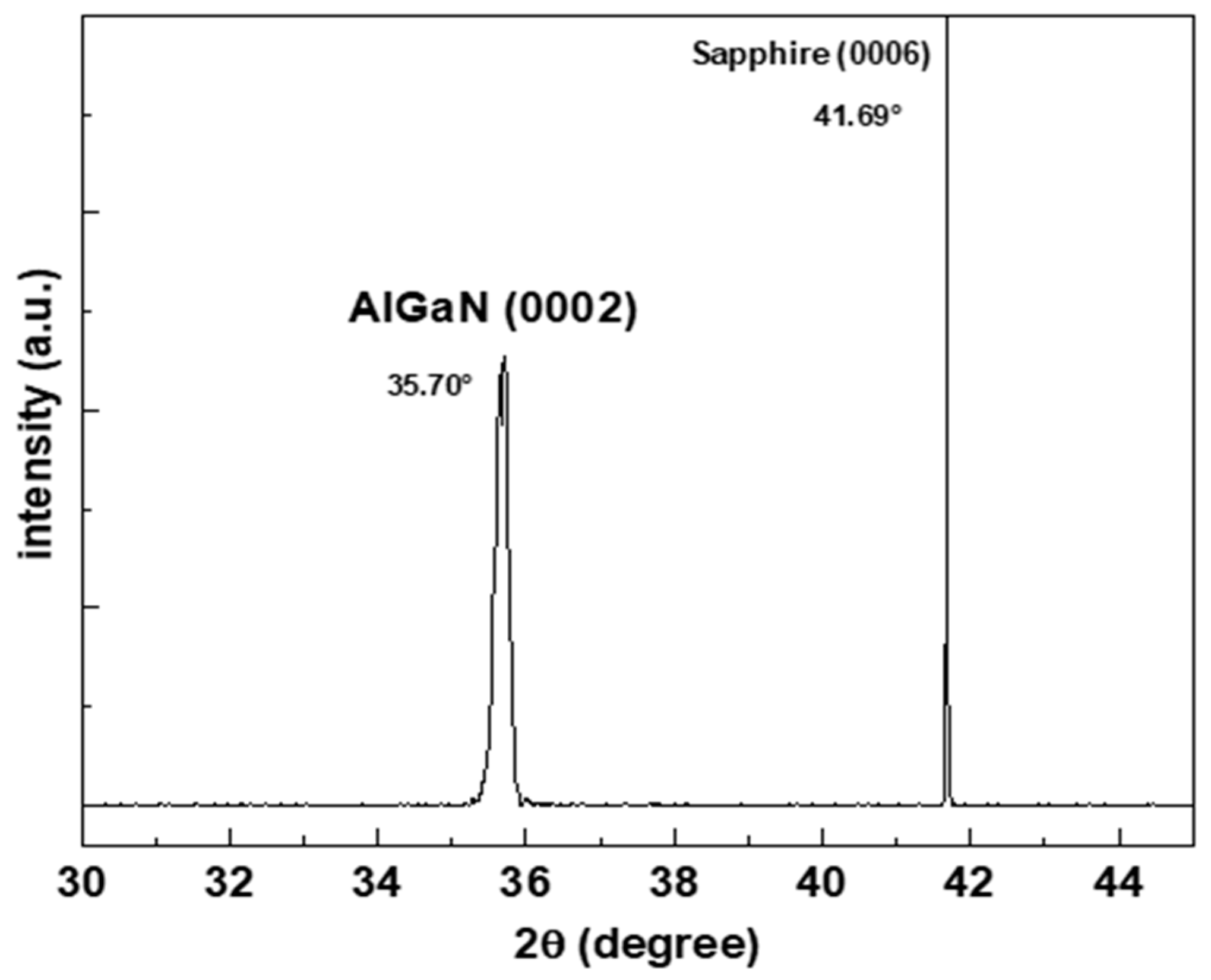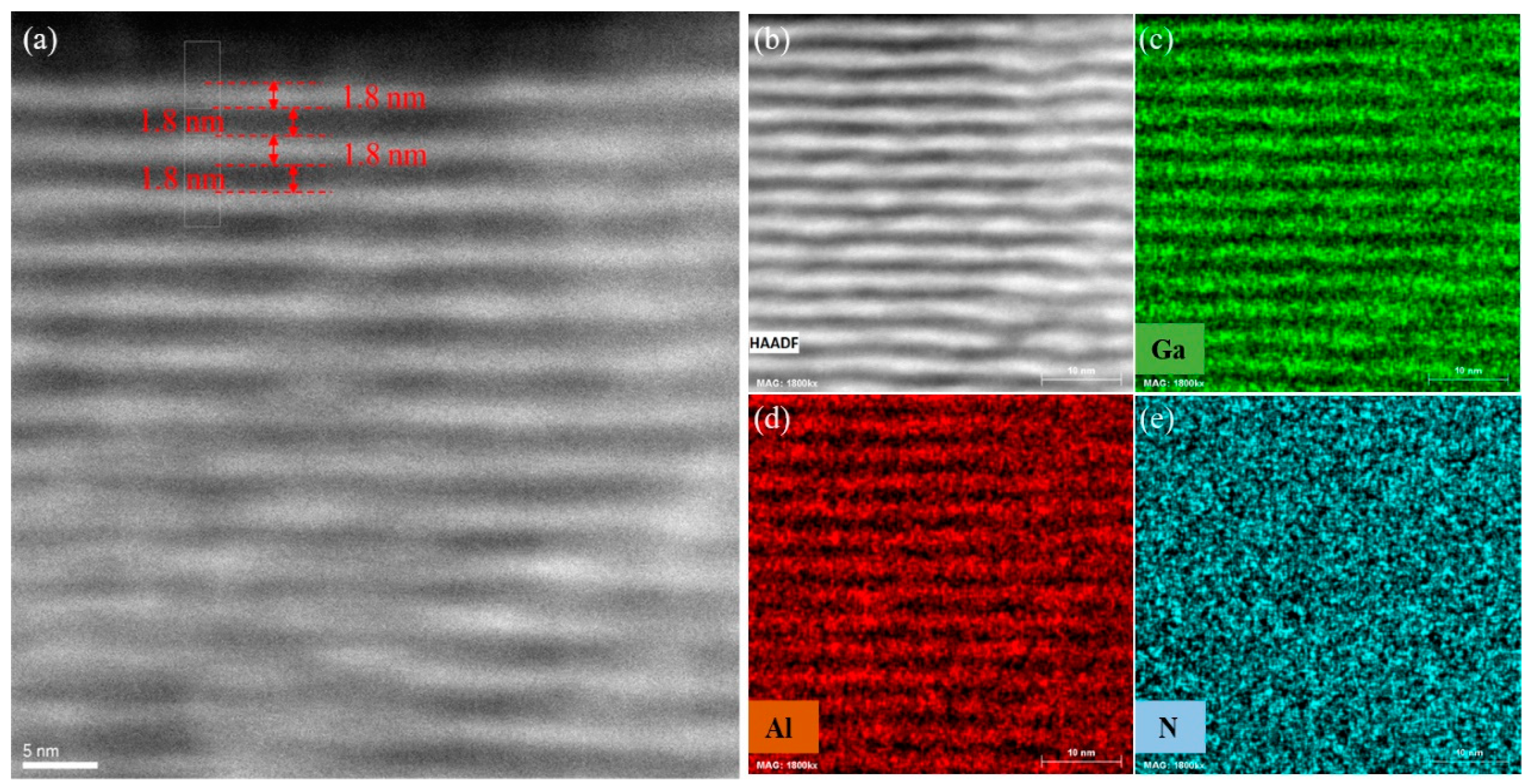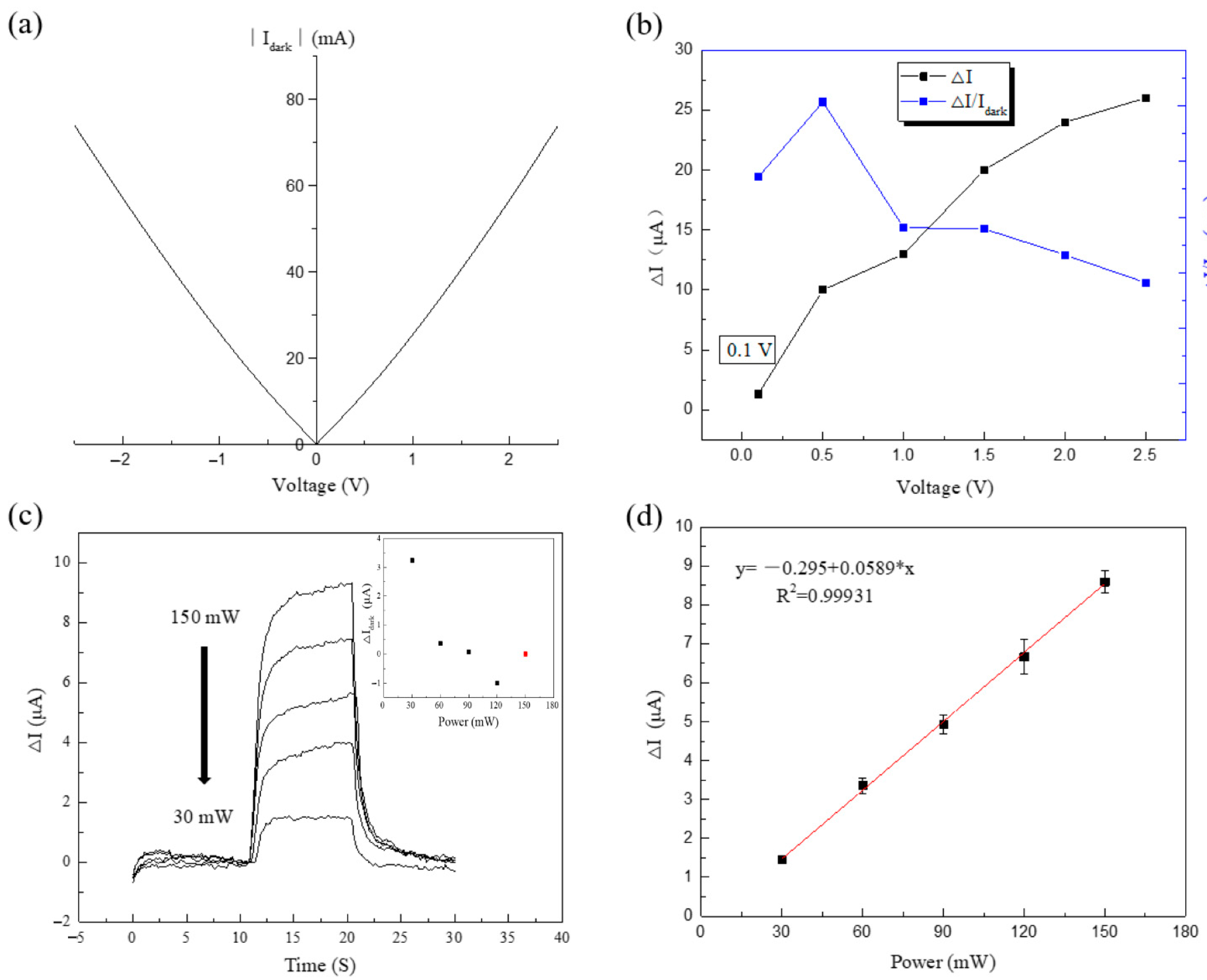GaN/AlN Multi-Quantum Wells Infrared Detector with Short-Wave Infrared Response at Room Temperature
Abstract
:1. Introduction
2. Experiment
2.1. Device Structure Design and Implementation
2.2. Structure Characterization and Infrared Detection Methods
2.3. Theoretical Calculation Method
3. Results and Discussion
4. Conclusions
Author Contributions
Funding
Institutional Review Board Statement
Informed Consent Statement
Data Availability Statement
Acknowledgments
Conflicts of Interest
References
- Cen, L.B.; Shen, B.; Qin, Z.X.; Zhang, G.Y. Near-Infrared Two-Color Intersubband Transitions in AlN/GaN Coupled Double Quantum Wells. J. Appl. Phys. 2009, 105, 1590. [Google Scholar] [CrossRef]
- Solaimani, M.; Izadifard, M. Miniband Formation Engineering in GaN/AlN Superlattices with Constant Total Effective Length. Opt. Quantum Electron. 2019, 51, 346. [Google Scholar] [CrossRef]
- Huang, C.C.; Xu, F.J.; Yan, X.D.; Song, J.; Xu, Z.Y.; Cen, L.B.; Wang, Y.; Pan, J.H.; Wang, X.Q.; Yang, Z.J.; et al. Intersubband Transitions at Atmospheric Window in AlxGa1−xN/GaN Multiple Quantum Wells Grown on GaN/Sapphire Templates Adopting AlN/GaN Superlattices Interlayer. Appl. Phys. Lett. 2011, 98, 132105. [Google Scholar] [CrossRef]
- Esaki, L. A New Photoconductor. IBM Tech. Discl. Bull. 1977, 20, 2456. [Google Scholar]
- Zheng, Z.W.; Shen, B.; Zhang, R.; Gui, Y.S.; Jiang, C.P.; Ma, Z.X.; Zheng, G.Z.; Guo, S.L.; Shi, Y.; Han, P. Occupation of the Double Subbands by the Two-Dimensional Electron Gas in the Triangular Quantum Well at AlxGa1−xN/GaN Heterostructures. Phys. Rev. B 2000, 62, R7739. [Google Scholar] [CrossRef]
- Beeler, M.; Trichas, E.; Monroy, E. III-Nitride Semiconductors for Intersubband Optoelectronics: A Review. Semicond. Sci. Technol. 2013, 28, 74022. [Google Scholar] [CrossRef]
- Suzuki, N.; Iizuka, N. Electron Scattering Rates in AlGaN/GaN Quantum Wells for 1.55 μm Inter-Subband Transition. Jpn. J. Appl. Phys. 1998, 37, L369. [Google Scholar] [CrossRef]
- Mensz, P.M.; Dror, B.; Ajay, A.; Bougerol, C.; Monroy, E.; Orenstein, M.; Bahir, G. Design and Implementation of Bound-to-Quasibound GaN/AlGaN Photovoltaic Quantum Well Infrared Photodetectors Operating in the Short Wavelength Infrared Range at Room Temperature. J. Appl. Phys. 2019, 125, 174505. [Google Scholar] [CrossRef]
- Tian, W.; Yan, W.Y.; Hui, X.; Li, S.L.; Ding, Y.Y.; Li, Y.; Chen, C.Q. Tunability of Intersubband Transition Wavelength in the Atmospheric Window in AlGaN/GaN Multi-Quantum Wells Grown on Different AlGaN Templates by Metalorganic Chemical Vapor Deposition. J. Appl. Phys. 2012, 112, 252. [Google Scholar] [CrossRef]
- Aleksandrov, I.A.; Malin, T.V.; Zhuravlev, K.S.; Trubina, S.V.; Erenburg, S.B.; Pecz, B.; Lebiadok, Y.V. Diffusion in GaN/AlN Superlattices: DFT and EXAFS Study. Appl. Surf. Sci. 2020, 515, 146001. [Google Scholar] [CrossRef]
- Davydov, V.; Roginskii, E.; Kitaev, Y.; Smirnov, A.; Eliseyev, I.; Nechaev, D.; Jmerik, V.; Smirnov, M. Phonons in Short-Period GaN/AlN Superlattices: Group-Theoretical Analysis, Ab Initio Calculations, and Raman Spectra. Nanomaterials 2021, 11, 286. [Google Scholar] [CrossRef] [PubMed]
- Chen, G.; Li, Z.L.; Wang, X.Q.; Huang, C.C.; Rong, X.; Sang, L.W.; Xu, F.J.; Tang, N.; Qin, Z.X.; Sumiya, M. Effect of Polarization on Intersubband Transition in AlGaN/GaN Multiple Quantum Wells. Appl. Phys. Lett. 2013, 102, 192109. [Google Scholar] [CrossRef]
- Shuangying, L.; Bo, S.; Fujun, X.; Zhijian, Y.; Ke, X.; Guoyi, Z. Influence of Polarization-Induced Electric Fields on Optical Properties of Intersubband Transitions in AlxGa1−xN/GaN Double Quantum Wells. Chin. J. Semicond. 2006, 27, 403–407. [Google Scholar]
- Hofstetter, D.; Schad, S.S.; Wu, H.; Schaff, W.J.; Eastman, L.F. GaN/AlN-Based Quantum-Well Infrared Photodetector for 1.55 μm. Appl. Phys. Lett. 2003, 83, 572–574. [Google Scholar] [CrossRef]
- Quach, P.; Liu, S.F.; Jollivet, A.; Wang, D.; Cheng, J.Y.; Isac, N.; Pirotta, S.; Bouville, D.; Sheng, S.S.; Imran, A. A GaN/AlN Quantum Cascade Detector with a Broad Response from the Mid-Infrared (4.1 μm) to the Visible (550 nm) Spectral Range. Appl. Phys. Lett. 2020, 116, 171102. [Google Scholar] [CrossRef]
- Sakr, S.; Crozat, P.; Gacemi, D.; Kotsar, Y.; Pesach, A.; Quach, P.; Isac, N.; Tchernycheva, M.; Vivien, L.; Bahir, G. GaN/AlGaN Waveguide Quantum Cascade Photodetectors at λ≈ 1.55 μm with Enhanced Responsivity And∼ 40 GHz Frequency Bandwidth. Appl. Phys. Lett. 2013, 102, 11135. [Google Scholar] [CrossRef]
- Vardi, A.; Bahir, G.; Guillot, F.; Bougerol, C.; Julien, F.H. Near Infrared Quantum Cascade Detector in GaN/AlGaN/AlN Heterostructures. Appl. Phys. Lett. 2008, 92, 11112–11113. [Google Scholar] [CrossRef]
- Sakr, S.; Giraud, E.; Dussaigne, A.; Tchernycheva, M.; Grandjean, N.; Julien, F.H. Two-Color GaN/AlGaN Quantum Cascade Detector at Short Infrared Wavelengths of 1 and 1.7 μm. Appl. Phys. Lett. 2012, 100, 2824. [Google Scholar] [CrossRef]
- Kang, D.D.; Inoue, T.; Asano, T.; Noda, S. Electrical Modulation of Narrowband GaN/AlGaN Quantum-Well Photonic Crystal Thermal Emitters in Mid-Wavelength Infrared. ACS Photonics 2019, 6, 1565–1571. [Google Scholar] [CrossRef]
- Song, Y.; Bhat, R.; Huang, T.Y.; Badami, P.; Zah, C.E.; Gmachl, C. III-Nitride Quantum Cascade Detector Grown by Metal Organic Chemical Vapor Deposition. Appl. Phys. Lett. 2014, 105, 182104. [Google Scholar] [CrossRef] [Green Version]
- Durmaz, H.; Nothern, D.; Brummer, G.; Moustakas, T.D.; Paiella, R. Terahertz Intersubband Photodetectors Based on Semipolar III-Nitride Quantum Wells. Appl. Phys. Lett 2016, 108, 201102. [Google Scholar] [CrossRef]
- Sudradjat, F.F.; Zhang, W.; Woodward, J.; Durmaz, H.; Moustakas, T.D.; Paiella, R. Far-Infrared Intersubband Photodetectors Based on Double-Step III-Nitride Quantum Wells. Appl. Phys. Lett. 2012, 100, 241113. [Google Scholar] [CrossRef]
- Hamazaki, J.; Matsui, S.; Kunugita, H.; Ema, K.; Kanazawa, H.; Tachibana, T.; Kikuchi, A.; Kishino, K. Ultrafast Intersubband Relaxation and Nonlinear Susceptibility at 1.55 μm in GaN/AlN Multiple-Quantum Wells. Appl. Phys. Lett. 2004, 84, 1102–1104. [Google Scholar] [CrossRef]
- Iizuka, N.; Kaneko, K.; Suzuki, N. Near-Infrared Intersubband Absorption in GaN/AlN Quantum Wells Grown by Molecular Beam Epitaxy. Appl. Phys. Lett. 2002, 81, 1803–1805. [Google Scholar] [CrossRef]
- Dror, B.; Zheng, Y.; Agrawal, M.; Radhakrishnan, K.; Orenstein, M.; Bahir, G. Mid-Infrared GaN/AlGaN Quantum Cascade Detector Grown on Silicon. IEEE Electron Device Lett. 2018, 40, 263–266. [Google Scholar] [CrossRef]
- Wang, D.; Su, J.; Chen, Z.; Wang, T.; Yang, L.; Sheng, B.; Lin, S.; Rong, X.; Wang, P.; Shi, X. Repeatable Room Temperature Negative Differential Resistance in AlN/GaN Resonant Tunneling Diodes Grown on Sapphire. Adv. Electron. Mater. 2019, 5, 1800651. [Google Scholar] [CrossRef]
- Wang, D.; Chen, Z.; Su, J.; Wang, T.; Zhang, B.; Rong, X.; Tan, W.; Guo, S.; Zhang, J.; Shen, B.; et al. Controlling Phase-Coherent Electron Transport in III-Nitrides: Toward Room Temperature Negative Differential Resistance in AlGaN/GaN Double Barrier Structures. Adv. Funct. Mater. 2020, 31, 2007216. [Google Scholar] [CrossRef]
- Cheng, J.; Quach, P.; Wang, D.; Liu, F.; Wang, X. Dominant Influence of Interface Roughness Scattering on the Performance of GaN Terahertz Quantum Cascade Lasers. Nanoscale Res. Lett. 2019, 14, 206. [Google Scholar] [CrossRef]
- Abstreiter, G.; Aydinli, A.; Leburton, J.P. Optical Spectroscopy of Low Dimensional Semiconductors; Springer: Berlin, Germany, 1997; Volume 344, ISBN 0792347285. [Google Scholar]
- Li, J.M.; Lu, Y.W.; Han, X.X.; Wu, J.J.; Liu, X.L.; Zhu, Q.S.; Wang, Z.G. Theoretical Investigation of Intersubband Transition in AlxGa1−xN/GaN/AlyGa1-yN Step Quantum Well. Phys. E 2005, 28, 453–461. [Google Scholar] [CrossRef]
- Zervos, M.; Kostopoulos, A.; Constantinidis, G.; Kayambaki, M.; Georgakilas, A. Investigation into the Charge Distribution and Barrier Profile Tailoring in AlGaN/GaN Double Heterostructures by Self-Consistent Poisson–Schrödinger Calculations and Capacitance–Voltage Profiling. J. Appl. Phys. 2002, 91, 4387–4393. [Google Scholar] [CrossRef]
- Xiao Li, J.I.; Fan, C.; Ruo-Lian, J.; Jian-Jun, Z.; Bo, W.; Ping, H.; Zi-Li, X.; Rong, Z.; You-Dou, Z. Investigation into the Energy Band Diagram and Charge Distribution in AlGaN/GaN Double Heterostructures by Self-Consistent Poisson–Schrödinger Calculations. Chin. Phys. Lett. 2005, 22, 454. [Google Scholar] [CrossRef]
- Brey, L.; Dempsey, J.; Johnson, N.F.; Halperin, B.I. Infrared Optical Absorption in Imperfect Parabolic Quantum Wells. Phys. Rev. B Condens. Matter 1990, 42, 1240–1247. [Google Scholar] [CrossRef] [PubMed]





| Parameter (Unit) | Value |
|---|---|
| The type of semiconductor | N-type |
| Resistivity (ohm·cm) | 4.2475 × 10−3 |
| Hall coefficient (cm3/C) | −1.3352 × 10−1 |
| Hall mobility (cm2/(v·s) | 3.1436 × 10−1 |
| Carrier concentration (cm−3) | 4.6749 × 1019 |
Publisher’s Note: MDPI stays neutral with regard to jurisdictional claims in published maps and institutional affiliations. |
© 2022 by the authors. Licensee MDPI, Basel, Switzerland. This article is an open access article distributed under the terms and conditions of the Creative Commons Attribution (CC BY) license (https://creativecommons.org/licenses/by/4.0/).
Share and Cite
Jiang, F.; Bu, Y. GaN/AlN Multi-Quantum Wells Infrared Detector with Short-Wave Infrared Response at Room Temperature. Sensors 2022, 22, 4239. https://doi.org/10.3390/s22114239
Jiang F, Bu Y. GaN/AlN Multi-Quantum Wells Infrared Detector with Short-Wave Infrared Response at Room Temperature. Sensors. 2022; 22(11):4239. https://doi.org/10.3390/s22114239
Chicago/Turabian StyleJiang, Fengqiu, and Yuyu Bu. 2022. "GaN/AlN Multi-Quantum Wells Infrared Detector with Short-Wave Infrared Response at Room Temperature" Sensors 22, no. 11: 4239. https://doi.org/10.3390/s22114239
APA StyleJiang, F., & Bu, Y. (2022). GaN/AlN Multi-Quantum Wells Infrared Detector with Short-Wave Infrared Response at Room Temperature. Sensors, 22(11), 4239. https://doi.org/10.3390/s22114239






